Albania
Zaimi, Perparim *
Captain Përparim Zaimi is the Albanian author of the bilingual publication Atlantida – Perandoria e atlantëve dhe shqiptarët… / 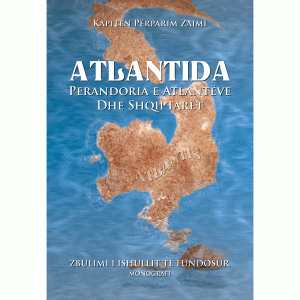 Atlantis – Empire of Atlanteans and Albanians: Discovery of Sunken Island published in 2013.
Atlantis – Empire of Atlanteans and Albanians: Discovery of Sunken Island published in 2013.
Zaimi wrote elsewhere “ The island of Atlantis with an area of about 400,000 Km2 (according to my calculations) sinks into the depths of the Atlantic Ocean and almost destroys the earliest and most advanced civilization that the ancient world has seen, always according to the explanations and stories left behind. Together with the Island of Atlantis, a giant land mass, in the shape of a peninsula of about 270 thousand km2, is separated from the Iberian peninsula and plunges into the depths of the Atlantic Ocean. The existence of this peninsula is discovered and mentioned for the first time by me in the scientific book Atlantis and the Empire of the Atlanteans.”(a)
For me, Zaimi’s credibility is completely undermined by his promotion of the idea of ancient extraterrestrial visitors.
(a) https://inforculture-info.translate.goog/2021/07/28/hartat-me-te-vjetra-te-planetit-toke-dhe-disa-spote-misterioze/ {Albanian) (There is a problem with translating this)
Strait of Otranto, The
The Strait of Otranto is a 45-mile stretch of water that separates the ‘heel’ of 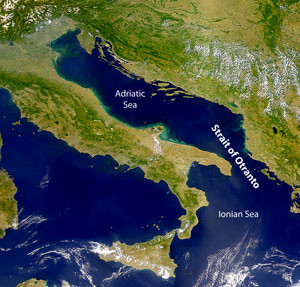 Italy from Albania at the entrance to the Adriatic Sea. It is also one of a number of proposed locations for the ‘Pillars of Heracles’ referred to by Plato. However, proponents of this idea are not agreed on the location of Atlantis, Fatih Hodži? places Atlantis in the Southern Adriatic Basin, while more recently, Alessio Toscano has opted for the northeastern Adriatic. An anonymous contributor to the all empires website(a) has an extensively illustrated entry, which designates the Albanian city of Durres as Atlantis and notes the multiplicity of locations that have referred to as the ‘Pillars of Heracles’, including the Strait of Otranto.
Italy from Albania at the entrance to the Adriatic Sea. It is also one of a number of proposed locations for the ‘Pillars of Heracles’ referred to by Plato. However, proponents of this idea are not agreed on the location of Atlantis, Fatih Hodži? places Atlantis in the Southern Adriatic Basin, while more recently, Alessio Toscano has opted for the northeastern Adriatic. An anonymous contributor to the all empires website(a) has an extensively illustrated entry, which designates the Albanian city of Durres as Atlantis and notes the multiplicity of locations that have referred to as the ‘Pillars of Heracles’, including the Strait of Otranto.
Caucasus Mountains
The Caucasus Mountains lie between the Black and Caspian Seas and contain the highest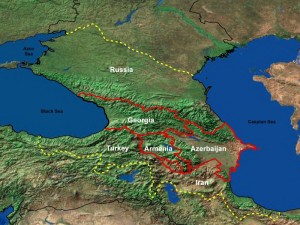 mountain in Europe, Mount Elbrus (Russia). In ancient times it was the location of several kingdoms of whom two were known as Albania and Iberia.(d)>Today, they contain a small part of the Russia Federation along with the former Soviet republics of Armenia, Azerbaijan and Georgia.<
mountain in Europe, Mount Elbrus (Russia). In ancient times it was the location of several kingdoms of whom two were known as Albania and Iberia.(d)>Today, they contain a small part of the Russia Federation along with the former Soviet republics of Armenia, Azerbaijan and Georgia.<
>Delisle de Sales was probably the first to suggest the Caucasus as the home of the original Atlantis, with refugees from there establishing Plato’s Atlantis in the Central Mediterranean. However, the greatest proponent of the Caucasus location for Atlantis was R.A. Fessenden who wrote, The Deluged Civilisation of the Caucasus Isthmus, an extensive multi-volume work [1012] on the subject published early in the 20th century.<
>Regarding the Pillars of Herakles being in the Caucasus Fessenden noted “The fact that Nebuchadnezzar, after reaching them in his northern expedition, next went to the north shore of the Black Sea and to Thrace; and that Hercules, coming back from the pillars with the cattle of Geryon, traversed the north shore of the Black Sea (see Megasthenes, quoted by Strabo and Herodotus, 4.8), puzzled the ancient geographers because they thought that the Pillars were at the straits of Gibraltar. And because they had overlooked the fact that the Phoenicians of Sidon had known that the Pillars had been lost and that the Phoenicians had sent out four expeditions to look for them but had reached no conclusion from these expeditions except that the straits of Gibraltar were not the true Pillars of Hercules.” See Strabo, 2.5 (m)<
More recently, Ronnie Gallagher, an admirer of Fessenden, has studied the Caucasus region, in particular,  the hydrology of the Caspian Sea(a), where he identified strandlines up to 225 metres above sea level (ASL), which he considers to be evidence of a vast inland Eurasian sea at the end of the last Ice Age. In Azerbaijan, he also found cart ruts similar to those on Malta as well as stone circles on the Absheron Peninsula(b). Professor E. N. Badyukova has offered some critical comments regarding Gallagher’s claims(k).
the hydrology of the Caspian Sea(a), where he identified strandlines up to 225 metres above sea level (ASL), which he considers to be evidence of a vast inland Eurasian sea at the end of the last Ice Age. In Azerbaijan, he also found cart ruts similar to those on Malta as well as stone circles on the Absheron Peninsula(b). Professor E. N. Badyukova has offered some critical comments regarding Gallagher’s claims(k).
Flinders Petrie also referenced Fessenden in his (1926) paper The Origins of the Book of the Dead(f), in which he concluded “that the cultural connections of the earliest Egyptians, as well as the physical descriptions in their mythology, point to the Caucasus region. When, further, we find there the names of the principal places of the mythology in their relative positions, it gives strong grounds for regarding that region as the homeland of the earliest civilisation of the Egyptians.”
A few years later, an article by Margaret A. Murray in Antiquity (Volume 15 – Issue 60 – Dec. 1941) noted that Petrie’s “opinion was based entirely on literary and philological evidence” resulting in archaeologists being slow to accept it. To partially counter this Murray offered two pieces of evidence in support of Petrie’s proposed Egyptian-Caucasus connection.(i)
However, I must point out that in 1874 Hyde Clarke delivered a paper to the Royal Anthropological Institute in which he claimed that the Colchians in the Caucasus had been an Egyptian colony(h). Clarke also employed language similarities>and Herodotus’ Histories (Bk2.102-106)< to support his contention. So we can reasonably ask, who was right or were both Clarke and Flinders Petrie wrong?
A forum on Graham Hancock’s website offered some more discussion about an Egyptian link with the Caucasus(j).
Jean-Michel Hermans has claimed that the megalith builders of Brittany originally came from the Caucasus, and arrived there after a stop in what is now Bulgaria around 5000 BC(l),>and while there, they discovered mathematical relationships such as ‘pi’ and the ‘golden ratio’ !<
The Amazons of Greek mythology are thought by some to have originated in the Caucasus and as late as 1671, Sir John Chardin reported that a tribe of Amazons existed in Georgia. Interestingly, a 19th-century photo shows two armed ladies from Armenia captioned as ‘Amazons of Armenia 1895’.
An added mystery was offered by Alexander Braghine, who recounted that “I was present when a former Russian officer of Georgian origin found himself able to talk with the natives of Vizcaya immediately upon his arrival in Northern Spain: he spoke Georgian, but the Basques understood this language.” [156.187]
Currently, Bruce Fenton has claimed the Caucasus as the home of giants. However, Jason Colavito has demonstrated the unreliability of his claims(c).
In the Krasnodar region of southern Russia hundreds (actually 3,000 and counting) of dolmens are to be found on both sides of the Caucasus. Interestingly, they show a distinctive form of megalithic architecture(g).
I feel that the Caucasus will have a lot more to tell us.
(a) Wayback Machine (archive.org)
(b) https://www.azer.com/aiweb/categories/magazine/ai103_folder/103_articles/103_cart_ruts.html
(d) https://en.wikipedia.org/wiki/Caucasian_Albania
(f) Archive 6947 | (atlantipedia.ie)
(g) The mysterious dolmens and megaliths of the Caucasus – The Tapestry of Time (larazzodeltempo.it)
(h) https://www.jstor.org/stable/pdf/2841305.pdf
(i) Antiquity, Vol. 15, Issue 60, Dec. 1941 p.384-386
(j) New article: Observations on Late Pleistocene Flooding of the… – Graham Hancock Official Website
(k) Archive 7221 | (atlantipedia.ie)
(l) Amazon.fr
Hushi, Skender (L)
Skender Hushi is an Albanian ‘researcher’ who recently announced to the world that he had discovered ‘Atlantide’. This dramatic ‘news’ is contained in a 55-page booklet, I Have Discovered Atlantide[0899], that was retailing at an exorbitant $32 (Kindle – $7).
Hushi bases his claim on the Emerald Plates of Thoth(c), who was allegedly the last king of Atlantis, which he claims lasted from 50,000 BC until 10,000 BC. He further claims that plain of Atlantis matches a description of Ireland, which he informs us was a former Albanian-speaking country!
It is obvious to me that Hushi knows as much about Ireland as he does about Atlantis. Like so many others who have entered into this field he does not know the difference between assertion and evidence. If anyone wishes to engage in some literary masochism, without paying the over inflated price of a hard copy, they can indulge themselves on Hushi’s website(a) where most of the text is available in badly translated English(b).
Hushi seems to locate Atlantis in the Atlantic, west of Ireland with Rockall its last visible remnant. His rambling text ranges over Giza, giants, pole shift, Incas, ancient space travel and the etymology of many Albanian words, which he assumes to have been the language of Atlantis!
(a) https://www.skenderhushi.net/
(b) https://docs.google.com/file/d/0Bwdwn73KfYKHTUZQdkY4c1BSTkU/edit?usp=drive_web&pli=1
Albania
Albania has not been excluded from the quest for links with Atlantis. Andi Zeneli had a website that delved into the ancient history of Albania which from the 10th century BC was part of Illyria. He makes great use of the controversial Oera Linda Book and linguistics in order to produce a convoluted association between Albania and Atlantis.
Zeneli had a separate website, also defunct, that dealt more specifically with the history of the ancient Illyrians.
There was also an ancient kingdom of Albania in the Caucasus between Iberia and and the Caspian Sea, approximately where Azerbaijan is now situated. It was once thought that the Adriatic Albanians had originated there but this was disproved on linguistic grounds in the 19th century.
 A more recent claim is that satellite imagery has revealed a network of lines near Durrés, west of Tirana, which are the remnants of Plato’s Atlantean canals, with co-ordinates of 41.08-41.02 N and 19.23 E. A blogsite(c) is also home to a number of articles adding further support to the Durrés theory.
A more recent claim is that satellite imagery has revealed a network of lines near Durrés, west of Tirana, which are the remnants of Plato’s Atlantean canals, with co-ordinates of 41.08-41.02 N and 19.23 E. A blogsite(c) is also home to a number of articles adding further support to the Durrés theory.
The Albanian hypothesis, however interesting has so far failed to answer many of the critical questions raised by Plato’s dialogues. Where were the Pillars of Heracles? What evidence is there for Albanian (Illyrian) influence extending to Tyrrhenia and Libya? Why did Plato not simply say that Atlantis had been located next door in the western Balkans? Without an answer to these and other questions we are forced to consider the Durres location is, at best, speculative.
However, in a desperate attempt to bolster this theory it has been pointed out(e) that the Illyrian tribe in the region was called Taulanti and the region itself Taulantis, inferring that it was modified to ‘Atlantis’!
In 2013 Skender Hushi announced that Albanian had been the language of Atlantis and Ireland!
A YouTube clip(d) offers a more graphic presentation of the theory while another link(f) offers a number of satellite images of Durres.
(c) https://atlantisinalbania.blogspot.com/2008/07/name-and-location.html
(d) https://www.youtube.com/watch?v=396VfgRH8Uw
(f) https://atlantisinalbania.blogspot.ie/2006/07/atlantis-is-in-albaniapt4eyes-dont.html
Adriatic Sea
The Adriatic Sea was mainly dry land during the last Ice Age until it was inundated between 8500-6000 BC. The last decade has seen a number of sites in 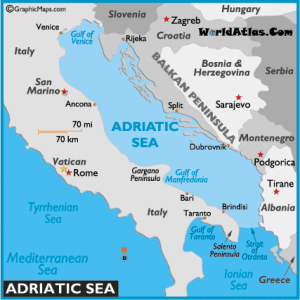 the Adriatic region nominated as possible locations for Atlantis. A sunken town near Zadar would appear to be the latest candidate(d).
the Adriatic region nominated as possible locations for Atlantis. A sunken town near Zadar would appear to be the latest candidate(d).
Fatih Hodzic, a Slovenian writer, has offered of a new theory(a), which places Atlantis in the southern Adriatic Basin. He contends that the destruction of Atlantis was a consequence of an asteroid impact, recorded in Greek mythology as Phaëton, impacting in either the Ionian or the Tyrrhenian Sea just west of Sicily.
Recently, Alessio Toscano has suggested that the Pillars of Heracles were situated at the Strait of Otranto and that Plato’s ‘Atlantic’ was in fact the Adriatic Sea(c).
The Italian side of the Adriatic has also had claims made of an association with Atlantis such as with Valbruna. Daniela Bortoluzzi has written a lengthy article suggesting a possible link between Atlantis and Venice(h). More detailed is the claim by Morven Robertson that Atlantis had been situated between Padua and Ferrara, not far from Venice.
Mljet is a Croatian island close to Dubrovnik and believed by some to be Homer’s Ogygia, which in turn has been identified as Atlantis. This same island offers a competing claim to be the place where St. Paul was shipwrecked on his way to Rome, rather than Malta. At the risk of offending my Maltese friends, I consider the Mljet claim to have some considerable merit. Apart from anything else, at that time ships, for reasons of safety, preferred to stay close to shore, which suggests that to use the Strait of Otranto would provide the shortest open sea journey available, after that the Strait of Messina would bring them straight up the Italian coast to Rome! I find it hard to understand how at any point on that route that a storm could have threatened to carry them to Syrtis Minor (Southern Tunisia) which was about 400 miles at the nearest point.
Dubrovnik was recently claimed to have a number of pyramids in its vicinity by Pero Metkovic as well as the location of Atlantis. His rather rambling blog(g) offers no evidence apart from over-imaginative speculation.
Another claim is that satellite imagery has revealed a network of lines near Durrés, west of Tirana in Albania, which are the remnants of Plato’s Atlantean canals. The co-ordinates are 41.08-41.02 N and 19.23 E. A blogsite(b) is also home to a number of articles adding support for this Durrés theory.
Andi Zineli, in a now defunct website, advocated an Albanian solution to the mystery of Atlantis. He employed the Oera Linda Book to support his theory.
While the above suggestions are interesting, they are not convincing. Does it not seem strange that had Atlantis been located in the Adriatic, next door to Greece, that the Greeks in general and Plato in particular would have been unaware of it?
The Adriatic was also the backdrop to Homer’s Odyssey according to a new book[1396] by Zlatko Mandzuka, himself a native of the region. Even more radical is the claim that Troy itself had been located in Bosnia-Herzegovina or adjacent Croatia, the former by Roberto Salinas Price in 1985[1544], while more recently the latter is promoted by Vedran Sinožic[1543].
When the sunken ruins of a city, dated to around 1500 BC were discovered in 2015, near Croatia’s oldest city, Zadar, it generated the usual flurry of Atlantis speculation.
There was a media report(f) in early 2017 in which Mark Kempf claimed to have discovered the remains of Atlantis 30 miles off the coast of Croatia. Kempf is a treasure hunter and hopes that the discovery by him and his team will yield a fortune. I consider this report to be somewhat dubious.
>Nevertheless, although it cannot be directly linked to Atlantis, I feel obliged to add a May 2023 report that a “prehistoric road was discovered under layers of sea mud at the sunken Neolithic site of Soline, and helped connect the Hvar settlement to the now-isolated island of Kor?ula in Croatia(i). The ‘road’ has been dated to around 5000 BC.<
(a) http://en.atlantida.spletnestrani.com/atlantida/
(b) http://atlantisinalbania.blogspot.com/2008/07/name-and-location.html
(c) http://templeofapollobelenus.blogspot.ie/
(d) https://www.reddit.com/r/worldnews/comments/3u7rce/archeologists_in_croatia_announced_their/
(f) https://empirenews.net/lost-city-of-atlantis-uncovered-in-mediterranean-sea/
(h) https://www.acam.it/tracce-di-atlantide-a-venezia/
(i) 7,000-Year-Old Ancient Road Found Buried Underneath the Mediterranean Sea! | Weather.com *
Satellite Imagery
Satellite Imagery has recently been introduced into the Atlantis search with a variety of location claims based on features visible from space. These assertions include Albania (2007), Andalusia, Spain (2003), Cyrenaica, Libya (2005) and Sherbro Island, Sierra Leone (2007). All such claims must, of necessity, be treated with extreme caution unless substantiated by archaeology on the ground (or underwater). At best, only one of the sites listed here can be correct and probably all are not, since Atlantis is supposed to have been submerged and so not yet readily visible to the scrutiny of our current aerial mapping technology.
A number of satellite images showing underwater anomalies have been claimed as evidence of Atlantis, but so far all have been shown to be the result of faulty data gathering and/or defective analysis of the data.
In 2010 there was a claim that Atlantis had been located with satellite imagery that placed it underwater between Bermuda and the Bahamas.
One of the most extreme claims based on images has come from Joseph P.Skipper who has identified some seafloor markings as an ancient script, apparently ignoring the fact that the lines of the writing would probably have to be a mile in width!
>Skipper also promoted the rectangular Google Earth images of the Atlantic, west of Gibraltar as the enormous ruins of manmade structures(c). Others claimed that the lines were ‘streets’. When Google explained that the images were a consequence of flawed data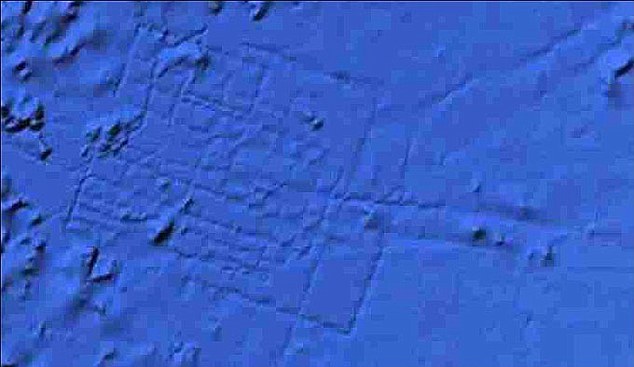 processing cries of ‘cover up’ could be heard. In the end, people believe what they want to believe.
processing cries of ‘cover up’ could be heard. In the end, people believe what they want to believe.
In April 3, 2018, British tabloids regurgitated the same flawed images under the familiar ‘Atlantis FOUND’ headline, this time crediting Blake Cousins as the ‘discoverer’(d).<
In July 2021 I was sent a number of images that purported to show anomalous underwater images in the Central Mediterranean northeast of Malta. At first sight, they appeared to show extensive manmade features. However, further investigation eventually revealed that the images were the consequence of the flawed computer interpretation of sonar data. In December 2021 Luigi Usai produced (a)(b) the same flawed imagery as evidence that he had discovered a lost submerged civilisation!
(a) Why didn’t scientists find Atlantis before Usai Luigi? ? Atlantis found!
(c) Ancient Atlantis or Another? (bibliotecapleyades.net) *
